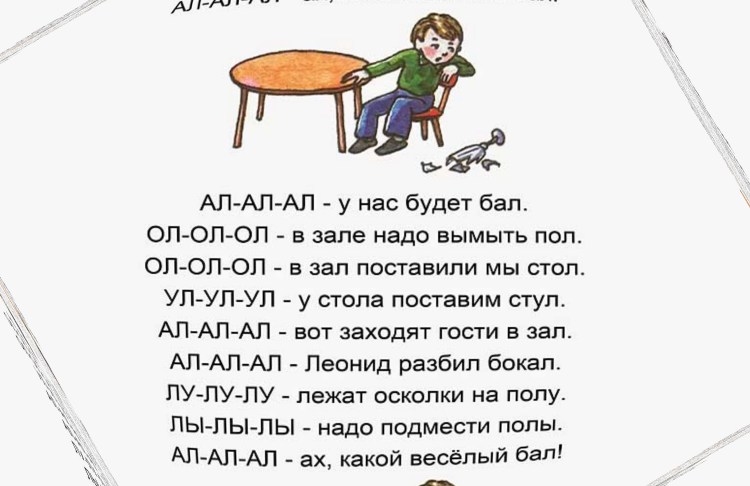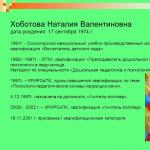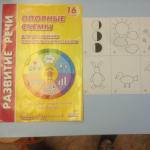Articulation exercises for sound l
Problems with diction are quite common in preschool children. Sometimes only the closest people can conduct a dialogue with the child; for the rest, the child's speech is incomprehensible, since he does not pronounce the letters or simply replaces them with others when talking. In this case, the child needs special classes that allow him to put the correct pronunciation of sounds, make speech intelligible, provide the baby and get rid of problems and complexes in the future, which often arise due to speech therapy disorders.
Articulatory gymnastics for the "L" sound is a set of exercises with which the child learns to pronounce this sound correctly. Classes are held with kids over 3 years old, it is better to give the child the correct pronunciation before school.
The principle and features of articulatory gymnastics for the sound "L"
The purpose of articulatory gymnastics is to explain to the child and consolidate, with the help of repetition of exercises, the position in which the speech organs (lips, tongue, palate) should be located at the time of pronouncing a certain sound. Having worked to automatism exactly what position the articular organs occupy at the moment of pronouncing a particular sound, the baby will learn to pronounce them clearly and correctly. Having learned how to make simple movements, form an intelligible sound, the baby can easily transform them into more complex ones, his speech will not only become understandable to those around him, but also his vocabulary will increase, and imaginative thinking will improve.
Articulatory gymnastics includes a set of static and dynamic exercises. It is performed daily, while the child should not only see an adult showing how to do the exercise correctly, but also himself, since the baby needs eye contact. If the child does not like the proposed small mirror, let him practice in front of the large one, because it will give the child the opportunity to feel more mature.
Classes are held only in a playful way, it is necessary to take into account the mood of the child. The complex usually takes 7-10 minutes and should not exceed a quarter of an hour for children 3-4 years old. Kids 5-6 years old do no more than 20 minutes. If the child finds it difficult to perform the exercises during this time, you can divide the complex into 2 parts. The exercises are performed while sitting, the back should be straight, it is necessary to monitor the baby's breathing.
With correct articulation, the sound "L" is pronounced:
- open lips;
- open teeth;
- the tip of the tongue rises and rests against the upper teeth;
- with a moderate air stream.
With the correct position of all speech organs, the sound "L" is voiced.
Exercises have well-established names, teaching the child how to perform each of them, you should try to make the child remember it. This will turn the activity into a game and save you from daily explanations of what exactly you want from the baby.
In order for the sounds to be pronounced correctly, it is necessary to achieve the mobility of the tongue, since it is he who is responsible for the pronunciation of sounds to the greatest extent. Exercise allows you to stretch the bridle - for most babies with pronunciation problems, it is short and not elastic enough. In addition, regular exercises train the muscles of the lips, tongue, teach the child to breathe correctly.
A set of dynamic exercises allows you to get a clear pronunciation.
"Turkey"
With the help of the exercise, the motor activity of the anterior region of the tongue develops and its upper rise is worked out.
The exercise is done with your mouth ajar. The tip of the tongue must be touched to the upper lip. Movements of the tongue back and forth are performed slowly at first, and then at an ever faster pace.
"Horse"
The exercise teaches the child to click, this strengthens the muscles of the tongue and helps the child to position it correctly at the moment the sound "L" is pronounced. Ask your baby to smile, showing his teeth, and click his tongue against the palate.
It is important not to move the lower jaw while doing this.
After the child learns to do this exercise, ask him to repeat, but without sound.
"Steamer"
The child stretches his lips in a smile, places the tip of his tongue between his teeth, bites it lightly and pronounces a lingering sound "Y".
Exercise "Brushing teeth"
It is performed with the mouth ajar. It is necessary to move the tongue from side to side on the inside of the teeth, imitating their brushing.
"Delicious jam"
With a wide tongue, the child licks the upper lip.

Static exercises
"Fence"
The child shows closed teeth in a smile.
"Cup"
Opening your mouth wide, you need to reach out with your tongue to the palate.
"Needle"
All exercises are performed 10-15 times. Doing static exercises, you must hold the position for 3-5 seconds.
Short rhymes containing several words with a certain sound, the correct pronunciation of which must be achieved, help to consolidate the result obtained during gymnastics.
- Summer rain pouring down from the sky
The forest washed in the morning. - They covered the bench with varnish,
All glistens in the sun.
And grandma is on the bench
He sits with pleasure. - Scarlet ribbon Larissa
Mom braided in a braid,
So little Lara
She was the most beautiful in the garden.
Ask your child to articulate words and sounds clearly.

How to fix the received result
To consolidate the result, it is necessary to pronounce syllables containing the letter "L" together with the child.
Lu-lu-lu, la-la-la; lo-lo-lo, ly-ly-ly.
To consolidate the result, use articulatory gymnastics for the sound "L" in pictures.
To do this, select pictures that depict objects or animals, in the names of which there is the letter "l". Moreover, it can be at the beginning, middle or end of a word. For example:
- Lily of the valley, frog, lion, skis.
- Pot, refrigerator, TV, coat.
- Glass, table, chair, pencil case.
Explain to the kid the meaning of unfamiliar words, in this case he will not only learn how to pronounce them correctly, but also enrich his vocabulary. The child must find the proposed picture and clearly articulate what exactly is depicted on it.
Pronounce complex words containing several letters "l", for example: sawed, poured, turned on, flew. In addition, words containing the sound "L" after consonants: eye, clay, evil person, hat, bug, beach, plafond, platform.
Of course, it is better if the classes are conducted by a professional speech therapist. Even if these are just a few activities, they will still be beneficial, since they will allow the mother to understand the algorithm of the necessary actions.
However, if this is impossible for objective reasons, you can deal with the baby on your own, using a variety of teaching materials, speech therapy cards and manuals that are widely available for sale. It should be remembered that the recommendations should be appropriate for the age of the child.
And, of course, classes should be systematic. Only in this case can a good result be achieved. Be persistent and patient, talk to your baby more often, address him with requests, carefully pronouncing the words, and your baby will definitely succeed.






